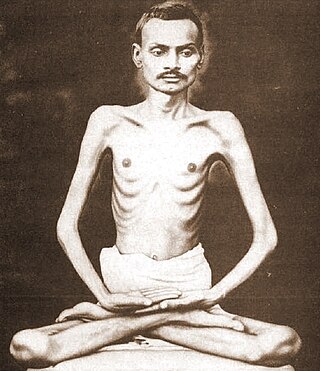Nirvana is a concept in Indian religions, the extinguishing of the passions which is the ultimate state of soteriological release and the liberation from duḥkha ('suffering') and saṃsāra, the cycle of birth and rebirth.

In Taoism, related traditions, and other Chinese religions and sects who incorporate it into their worldviews, the Tao or Dao is the natural way of the universe, whose character one's intuition must discern to realize the potential for individual wisdom, as conceived in the context of East Asian philosophy, religion, and related traditions. This seeing of life cannot be grasped as a concept. Rather, it is seen through actual living experience of one's everyday being. Its name derives from a Chinese character with meanings including 'way', 'path', 'road', and sometimes 'doctrine' or 'principle'.
Eastern philosophy or Asian philosophy includes the various philosophies that originated in East and South Asia, including Chinese philosophy, Japanese philosophy, Korean philosophy, and Vietnamese philosophy; which are dominant in East Asia, and Indian philosophy, which are dominant in South Asia, Southeast Asia, Tibet, and Mongolia.
Moksha, also called vimoksha, vimukti, and mukti, is a term in Hinduism, Buddhism, Jainism and Sikhism for various forms of emancipation, liberation, nirvana, or release. In its soteriological and eschatological senses, it refers to freedom from saṃsāra, the cycle of death and rebirth. In its epistemological and psychological senses, moksha is freedom from ignorance: self-realization, self-actualization and self-knowledge.
In Ancient Greek philosophy, ataraxia —generally translated as "unperturbedness", "imperturbability", "equanimity", or "tranquility"— is a lucid state of robust equanimity characterized by ongoing freedom from distress and worry. In non-philosophical usage, ataraxia was the ideal mental state for soldiers entering battle. Achieving ataraxia is a common goal for Pyrrhonism, Epicureanism, and Stoicism, but the role and value of ataraxia within each philosophy varies in accordance with their philosophical theories. The mental disturbances that prevent one from achieving ataraxia also vary among the philosophies, and each philosophy has a different understanding as to how to achieve ataraxia.

Sādhanā is an ego-transcending spiritual practice. It includes a variety of disciplines in Hindu, Buddhist and Jain traditions that are followed in order to achieve various spiritual or ritual objectives.
Nekkhamma is a Pāli word generally translated as "renunciation" or "the pleasure of renunciation" while also conveying more specifically "giving up the world and leading a holy life" or "freedom from lust, craving and desires." In Buddhism's Noble Eightfold Path, nekkhamma is the first practice associated with "Right Intention." In the Theravada list of ten perfections, nekkhamma is the third practice of "perfection." It involves non-attachment (detachment).
Stoic passions are various forms of emotional suffering in Stoicism, a school of Hellenistic philosophy.

Shrimad Rajchandra was a Jain poet, mystic, philosopher, scholar, and reformer. Born in Vavaniya, a village near Morbi, he claimed to have recollection of his past lives at the age of seven. He performed Avadhāna, a memory retention and recollection test that gained him popularity, but he later discouraged it in favour of his spiritual pursuits. He wrote much philosophical poetry including Atma Siddhi. He also wrote many letters and commentaries and translated some religious texts. He is known for his teachings on Jainism and his spiritual guidance to Mahatma Gandhi.

Dada Bhagwan, also known as Dadashri, born Ambalal Muljibhai Patel, was an Indian spiritual leader from Gujarat who founded the Akram Vignan Movement. He was spiritually inclined from an early age. He worked as a contractor for a company maintaining dry docks in Bombay before attaining "self-realization" in 1958. He left business and focused on his spiritual goals. The movement around his teaching grew into the Akram Vignan movement gaining followers in western India and abroad. Ahimsa (non-violence) and vegetarianism are an important part of Dada's teachings.

The credit for introducing Jainism to the West goes to a German scholar, Hermann Jacobi, who translated some Jain literature and published it in the series 'Sacred Books of East' in 1884. In Europe, the largest Jain populations are in Britain, with a population of about 25,000.
The Qingjing Jing is an anonymous Tang Dynasty Taoist classic that combines philosophical themes from the Tao Te Ching with the logical presentation of Buddhist texts and a literary form reminiscent of the Heart Sutra. It instructs students of the Tao to practice the elimination of desire in order to cultivate spiritual purity and stillness.
Non-possession is a religious tenet followed in Buddhist, Hindu, and Jain traditions in South Asia. In Jainism, aparigraha is the virtue of non-possessiveness, non-grasping, or non-greediness.
Equanimity is a state of psychological stability and composure which is undisturbed by the experience of or exposure to emotions, pain, or other phenomena that may cause others to lose the balance of their mind. The virtue and value of equanimity is extolled and advocated by a number of major religions and ancient philosophies.
Apatheia, in Stoicism, refers to a state of mind in which one is not disturbed by the passions. It might better be translated by the word equanimity than the word indifference. The meaning of the word apatheia is quite different from that of the modern English apathy, which has a distinctly negative connotation that includes feelings of inertness, indifference, and impassiveness. According to the Stoics, apatheia was the quality that characterized the sage.

Stoicism is a school of Hellenistic philosophy that flourished in Ancient Greece and Ancient Rome. The Stoics believed that the practice of virtue is enough to achieve eudaimonia: a well-lived life. The Stoics identified the path to achieving it with a life spent practicing the four virtues in everyday life: wisdom, courage, temperance or moderation, and justice, and living in accordance with nature. It was founded in the ancient Agora of Athens by Zeno of Citium around 300 BC.

Rakesh Jhaveri, also known as Pujya Gurudevshri Rakeshbhai and Pujya Gurudevshri Rakeshji, is a spiritual leader, mystic, scholar of Jainism, author and orator from India. Spiritually inclined from a young age, he is a follower of Shrimad Rajchandra, a Jain spiritual teacher. He completed doctoral studies on Shrimad's work Atmasiddhi. He founded Shrimad Rajchandra Mission, Dharampur which supports spiritual and social activities.
Atma Siddhi Shastra is a spiritual treatise in verse, composed in Gujarati by the nineteenth century Jain saint, philosopher poet Shrimad Rajchandra (1867–1901). Atma according to Jainism means "soul" or the "self" and "siddhi" means "attainment". Hence, Atma Siddhi is translated as self attainment or self realization. It is a composition of 142 verses in Gujarati, explaining the fundamental philosophical truths about the soul and its liberation. It propounds six fundamental truths on soul which are also known as satapada.
The teachings of the Baháʼí Faith regard Buddhism as a religion founded by a Manifestation of God, and Baháʼu'lláh as the expected Maitreya Buddha. The authenticity of the current canon of Buddhist scriptures is seen as uncertain. In recent years there has been an increase in the number of Baháʼís from Buddhist background.
Self-realization is a term used in Western psychology, philosophy, and spirituality; and in Indian religions. In the Western understanding, it is the "fulfillment by oneself of the possibilities of one's character or personality". In the Indian understanding, self-realization is liberating knowledge of the true self, either as the permanent undying Purusha or witness-consciousness, which is atman (essence), or as the absence (sunyata) of such a permanent self.







